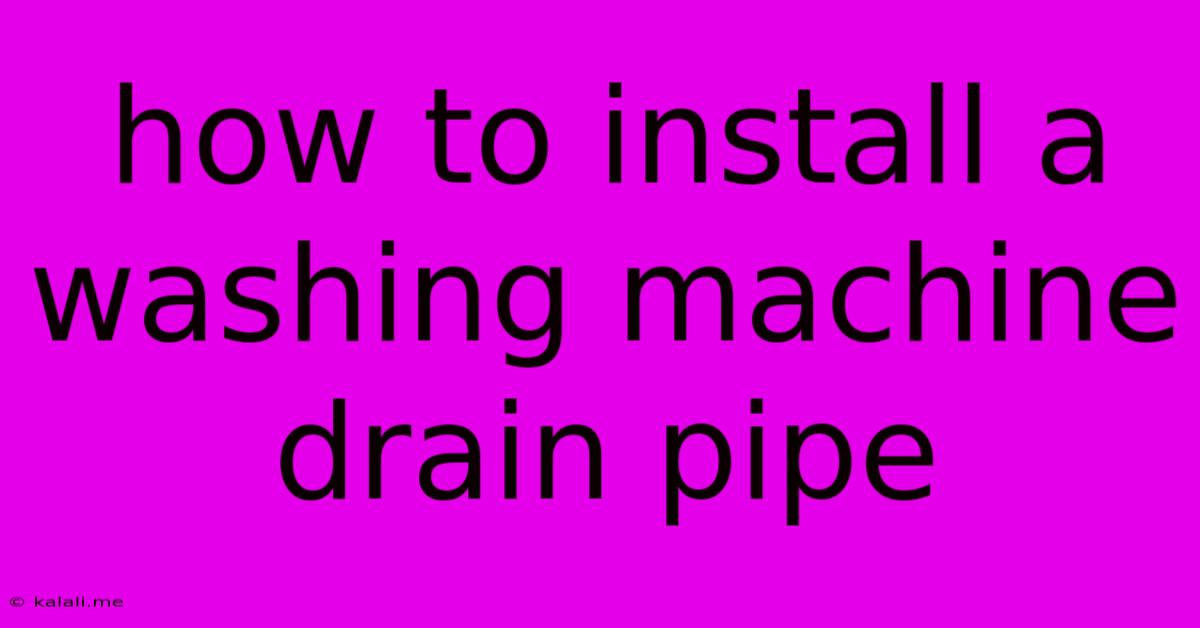How To Install A Washing Machine Drain Pipe
Kalali
Jun 01, 2025 · 3 min read

Table of Contents
How to Install a Washing Machine Drain Pipe: A Step-by-Step Guide
Meta Description: Learn how to properly install a washing machine drain pipe to prevent leaks and ensure efficient operation. This step-by-step guide covers everything from choosing the right pipe to securing the connection. Avoid costly plumbing repairs with our expert advice!
Installing a washing machine drain pipe might seem daunting, but with the right tools and a little know-how, it's a manageable DIY project. A correctly installed drain pipe is crucial for preventing leaks and ensuring your washing machine operates efficiently. This guide will walk you through the process, from choosing the right materials to securing the final connection.
Choosing the Right Drain Hose and Materials
Before you begin, gather your materials. You'll need:
- A washing machine drain hose: Ensure it's the correct length and diameter for your machine. Most washing machines come with a standard drain hose, but you might need a longer one depending on your plumbing setup. Look for a high-quality hose that's resistant to kinking and cracking.
- PVC pipe (optional): If your standpipe is too far, or inconveniently located, you might need PVC pipe to extend the reach. Use high-quality PVC pipe and appropriate fittings.
- PVC cement (optional): Required if using PVC pipe extensions.
- Pliers or adjustable wrench: For tightening connections.
- Measuring tape: To accurately measure distances.
- Bucket or towels: To catch any spills.
Step-by-Step Installation Guide
1. Preparing the Standpipe: Locate your laundry sink's standpipe. This is the vertical pipe designed to receive the washing machine's drain hose. It typically has a small opening near the top, specifically designed for this purpose. Clean the standpipe opening thoroughly to ensure a secure connection.
2. Measuring and Cutting (if necessary): If you need to extend the drain hose with PVC pipe, measure the distance carefully. Cut the PVC pipe to the required length using a pipe cutter for a clean cut to ensure a good seal. Remember to add a little extra length for adjustments.
3. Assembling PVC Extensions (if necessary): If you've used PVC pipe, carefully assemble the sections using appropriate PVC fittings. Apply PVC cement according to the manufacturer's instructions to create a watertight seal. Allow sufficient drying time before proceeding.
4. Connecting the Drain Hose: Attach the drain hose to the washing machine's drain outlet. This connection usually involves a simple clamp or bayonet fitting. Ensure the connection is secure and watertight.
5. Securing the Drain Hose to the Standpipe: Carefully feed the free end of the drain hose into the standpipe opening. It should fit snugly. The hose should loop over the top of the standpipe, making a high loop to prevent siphoning. This loop should be at least 60cm high. The loop prevents wastewater from flowing back into the washing machine. Make sure the loop is not excessively high as this can stress the hose and lead to future issues.
6. Securing the Hose Loop: The hose loop should be secured to prevent it from falling. You can use a twist tie, hose clamp or other suitable securing device. Avoid over-tightening, and check for any kinks in the hose that could restrict water flow.
7. Testing the Connection: Once everything is connected, turn on the water supply to your washing machine and run a short test cycle. Carefully check all connections for leaks.
Troubleshooting Common Problems
- Leaking Connections: Double-check all connections, paying particular attention to the hose clamps and PVC joints. If leaks persist, you might need to re-tighten connections or replace faulty components.
- Clogged Drain: A clogged drain can cause water to back up. Use a drain snake or plunger to clear any blockages.
- Incorrect Hose Height: Ensure the hose loop is at the correct height to prevent siphoning.
By following these steps, you can successfully install your washing machine drain pipe. Remember, safety and proper installation are key to preventing plumbing problems and ensuring your washing machine operates efficiently for years to come. If you are uncomfortable undertaking this task, always consult a qualified plumber.
Latest Posts
Latest Posts
-
How Do You Get Carpet Glue Off Of Cement
Jun 02, 2025
-
Grand Central Station To Times Square
Jun 02, 2025
-
Why Is Bipartite Graph Same As Two Color
Jun 02, 2025
-
As Useless As Tits On A Bull
Jun 02, 2025
-
How To Get Burnt Milk Off Glass Stove
Jun 02, 2025
Related Post
Thank you for visiting our website which covers about How To Install A Washing Machine Drain Pipe . We hope the information provided has been useful to you. Feel free to contact us if you have any questions or need further assistance. See you next time and don't miss to bookmark.